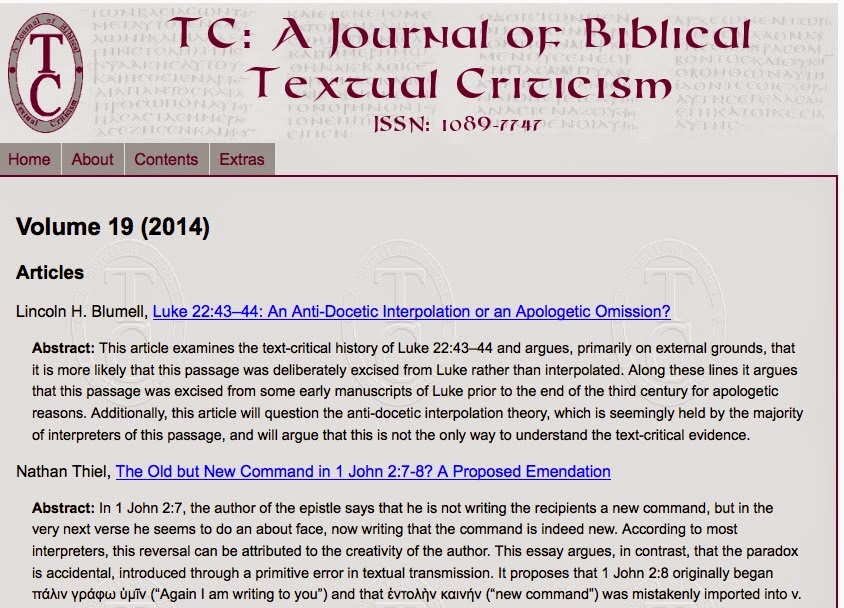The History and Text of New Testament Commentaries
The provisional timetable is now available for the Ninth Birmingham Colloquium, to be held on 2nd-4th March 2015, and is included in this message below.
Booking continues to be open for a couple of weeks: please use the form which can be downloaded from:
http://arts-itsee.bham.ac.uk/itseeweb/conferences/9Coll-booking.pdf
We hope to welcome you to Birmingham in March.
Hugh Houghton (here via an email)
Monday 2nd March
From 2pm: Registration
2.30pm Welcome
2.45pm Ronald Heine, “Origen’s Gospel Commentaries”
3.40pm Carl J. Berglund, “Quotation practices in Origen’s Commentary on the Gospel of John: How dependable are his quotations of John, Paul and Heracleon?”
4.30pm Christina Kreinecker, “The Biblical Text in Rufinus’ Translation of Origen’s Commentary on Romans”
5.00pm Rory P. Crowley, “Justin’s Dialogue 88 and His Commentaries on the Baptism Material: Implications for the Variant Form of the Heavenly Voice in Luke 3:22”
5.30pm Rosalind MacLachlan, “The Context of Commentary: Non-Biblical Commentaries in the Early Christian Period”
Tuesday 3 March
9.00am Lukas J. Dorfbauer, “The Rediscovery of a Supposedly Lost Fourth-Century Work: Bishop Fortunatianus of Aquileia and his Commentary on the Gospels”
9.45am Susan Griffith, “Sources and texts in Ambrose’s Commentary on Luke”
10.15am Thomas O’Loughlin, “Capitula as commentary in the Sermon on the Mount (Mt 5:1-7:28): the implicit exegesis in Latin division systems
11.15am Shari Boodts & Gert Partoens, “The critical edition of Florus of Lyons’ Expositio epistolarum beati Pauli apostoli. State of the art and new results.”
11.45am Maria Valeria Ingegno, “Patristic Sources for the Pauline Epistle Commentary of Gilbert de la Porée”
12.15pm Alexander Andrée, “Peter Comestor and the Glossa 'ordinaria' on the Gospels”
Afternoon excursion to Worcester
Wednesday 4 March
9.00am Gilles Dorival, “Biblical catenae”
10.00am Klaus Wachtel, “Coherence and History: Commentary Manuscripts in Acts and the Catholic Letters”
10.30am John Gram and Bruce Morrill, “Parsing Paul: Layout and Sampling Divisions in Pauline Commentaries”
12 noon Will Lamb, “Catenae and the Art of Memory”
12.45pm Dora Panella, “Jesus’ Post-resurrection appearances in 1Cor 15:5-8 and their interpretation in the catenae of Oecumenius, Theophylact and Zygabenus.”
2.15pm Matthias Schulz, “Catena Manuscripts in the Coptic Tradition – An Overview”
2.45pm Carol Downer, "A consideration of some texts from de Lagarde's Coptic Catena"
3.00pm Carla Falluomini, “The citations of the Gothic New Testament in the Skeireins commentary”
4.00pm Garick V. Allen, “The Scholia in Apocalypsin: The Edition of P. Tzamalikos (2013) and Scriptural Interpretation in Manuscript 2351”
4.30pm Agnès Lorrain, “Theodoret’s text of Romans”
5.00pm Jan Krans “Romans in the Hands of Radical Commentators”
5.30pm Concluding round table
7.00pm Colloquium dinner with address by Prof. Gordon Campbell.
This timetable will also be available at:
http://www.birmingham.ac.uk/research/activity/itsee/news/2015/birmingham-colloquium-2015-programme.aspx























